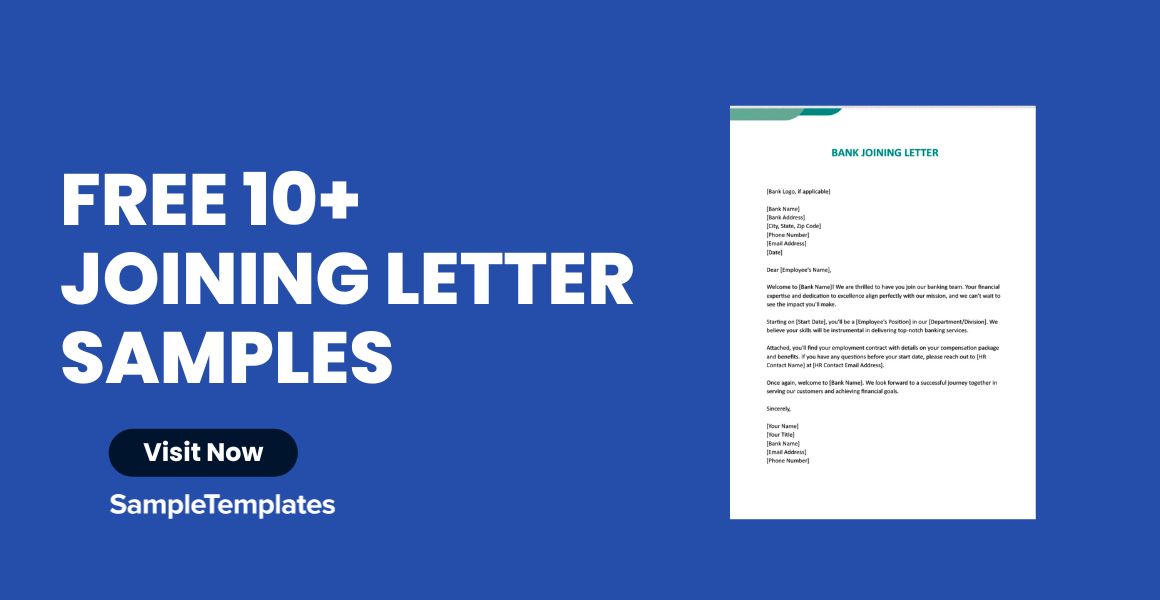Stepping into a new role is a landmark moment that deserves a professionally tailored Sample Joining Letter Template. This critical piece of communication not only confirms your acceptance of the new position but also demonstrates your professionalism from day one. With our comprehensive templates, smoothly transition into your new job by clearly outlining your acceptance and expressing your readiness to join the team. Our appointment letter templates are infused with the essential elements that reflect commitment and set the stage for your upcoming career endeavors. Perfect for anyone taking on a new challenge, these joining letter samples bridge the gap between accepting an offer and your first day, ensuring you convey the right tone of enthusiasm and competence to your new employer.
1. Sample Joining Letter Template

2. Blank Joining Letter Template

3. New Joining Letter Template
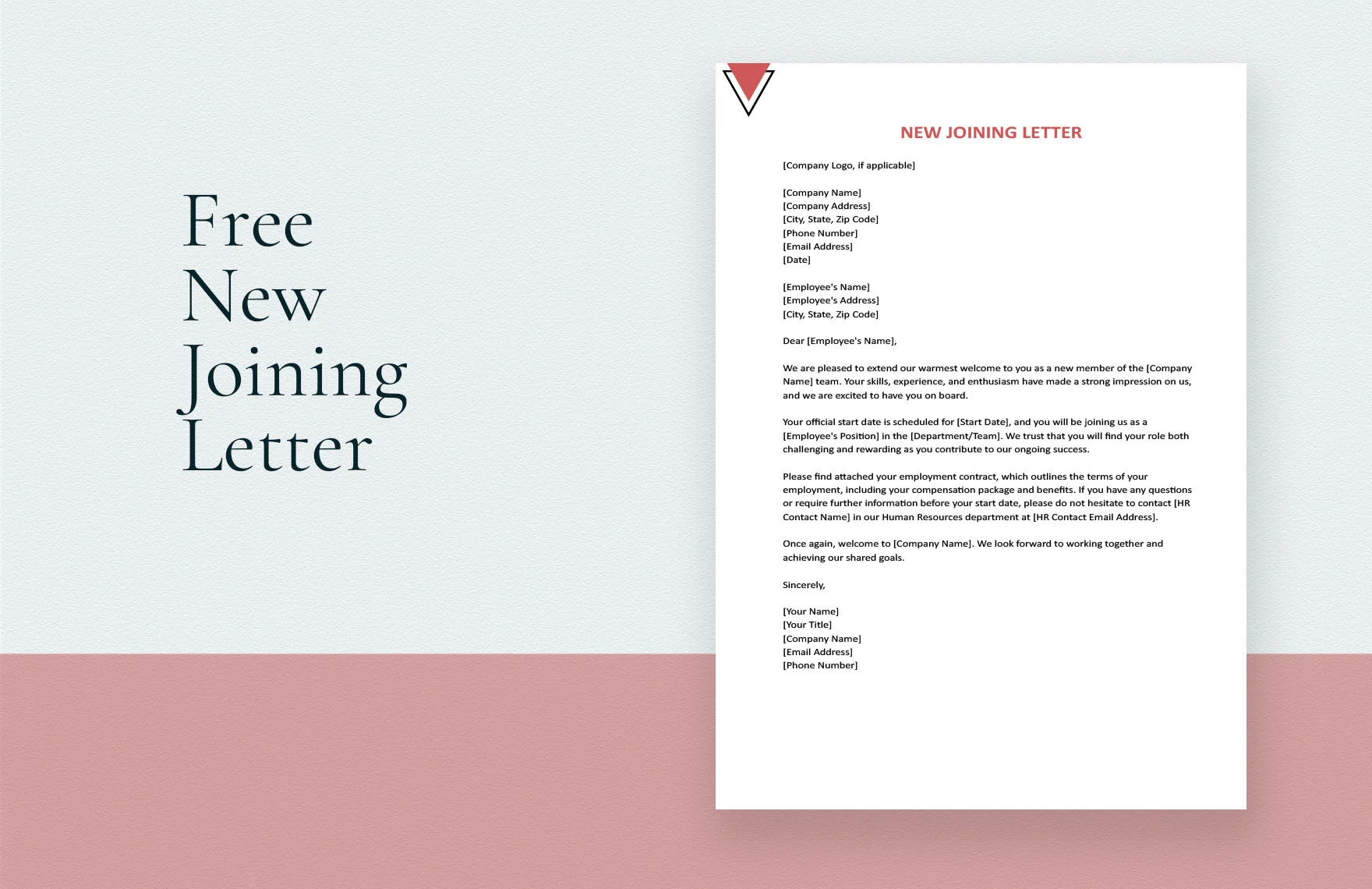
What is a Joining Letter?
A joining letter is the professional correspondence a candidate sends to an employer to formally accept a job offer. This letter is the final piece in the recruitment puzzle, signaling the end of the hiring process and the beginning of a new professional relationship. It outlines the candidate’s intention to join the company, affirming the details agreed upon, such as the role, salary, and start date.
The Importance of a Joining Letter
The joining letter serves several important functions. It acts as a courteous gesture of acceptance, a confirmation of the terms of employment, and a recorded commitment to the start date. For employers, it’s a key document that triggers the onboarding process, allowing them to finalize administrative preparations for the new hire.
Crafting the Perfect Joining Letter
Creating an effective joining letter requires attention to detail and a clear understanding of its components. It typically begins with a note of thanks, followed by a concise confirmation of the job details, and concludes with a personal expression of enthusiasm for the new opportunity.
Key Elements to Include in a Joining Letter
When drafting a joining letter, certain elements are non-negotiable. These include the date, a formal salutation, a statement of acceptance, the agreed-upon employment terms, and a professional closing.
How to Format Your Joining Letter
The format of a joining letter should adhere to professional standards. It should be typed on a plain white background, preferably in a standard font, and should not exceed one page. The layout should follow a standard business letter format, with evenly set margins and clear section breaks.
The Tone and Language of a Joining Letter
The tone of a joining letter is crucial—it should be professional, positive, and respectful. It is a reflection of your professionalism and can set the stage for your future interactions with your new employer.
Final Steps Before Sending Your Joining Letter
Before sending the joining letter, it’s imperative to proofread it for any errors. A well-crafted letter should be free from grammatical mistakes and should accurately reflect all the job offer details. This step ensures that your first official communication with your new employer is polished and professional.
Understanding the Distinction Between a Joining Letter and an Appointment Letter
It’s important to distinguish between a joining letter and an appointment letter. The former is sent by the candidate to accept the job officially, while the latter is provided by the employer offering the position and outlining the terms of employment.
The Role of a Joining Letter in the Onboarding Process
The joining letter plays a vital role in the onboarding process. It allows HR to prepare for the candidate’s arrival, ensuring that the workspace, equipment, and necessary training are ready. It also initiates the creation of employee records and inclusion in payroll systems.
Tips for Writing an Effective Joining Letter
Writing an effective joining letter is a skill that can be honed with a few tips. Keep the letter concise, focus on the positive aspects of the job offer, and express your readiness to contribute to the company’s success. This approach not only confirms your acceptance but also demonstrates your proactive attitude.
Conclusion: The First Step to a Successful Career Journey
A joining letter is more than just a formality—it is the first step in a successful career journey. It lays the foundation for a productive working relationship and showcases your commitment to professional excellence. Crafting a thoughtful joining letter can help ensure a smooth transition into your new role and create a lasting positive impression.
4. Company Joining Letter Template
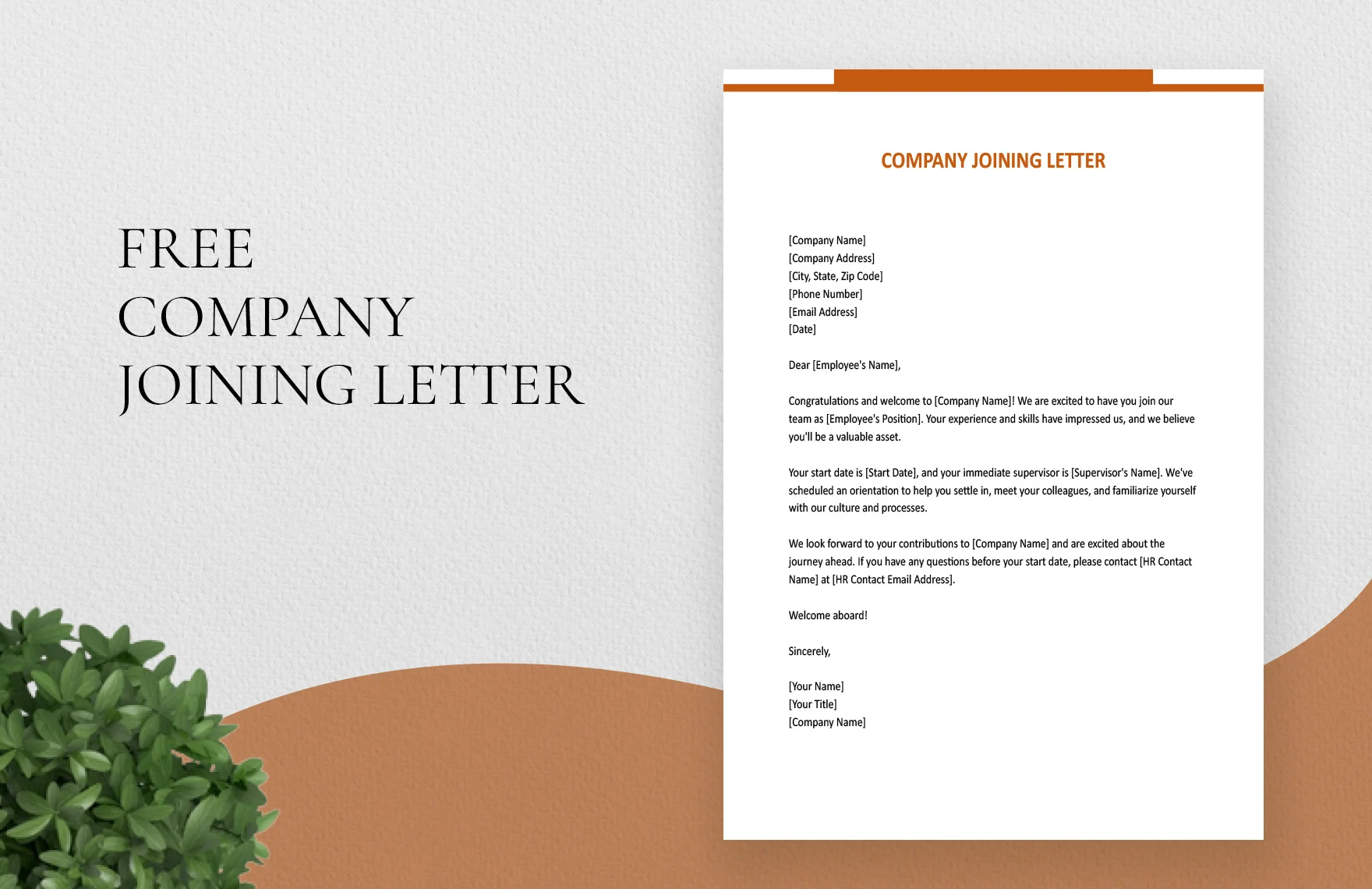
5. Request Joining Letter Template
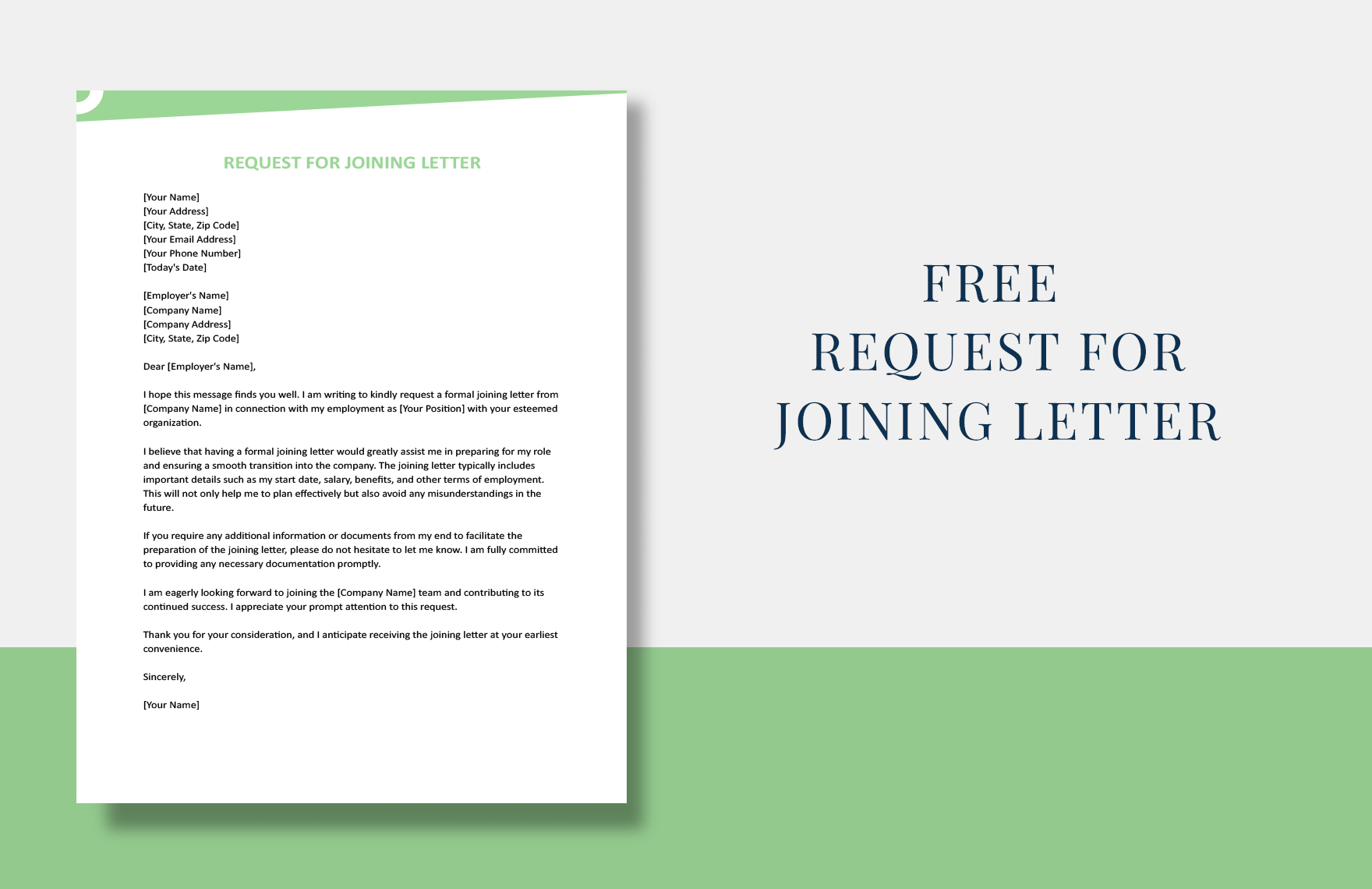
How to Write a Joining Letter?
Writing a joining letter is a critical step in finalizing your employment terms and officially starting your new role. A well-crafted joining letter not only demonstrates your professionalism but also your enthusiasm for the opportunity at hand. Here’s a comprehensive guide to help you write an effective joining letter.
Understanding the Purpose of a Joining Letter
A joining letter is a formal communication to your new employer, confirming your acceptance of their job offer. This document should affirm the details of the offer, such as your start date, position, and salary, and showcase your readiness to become part of the organization.
Starting with the Basics
The structure of a joining letter is similar to that of a standard business letter. Begin with your contact information, followed by the date, and then the employer’s contact information. Use a professional salutation to address the HR manager or the person who offered you the position.
Expressing Gratitude
The opening paragraph should always express gratitude for the job offer. This sets a positive tone for the letter and reflects well on your character as an appreciative and courteous professional.
Confirming the Job Offer Details
The main body of the joining letter should reiterate the key terms of your employment. Clearly state your job title, start date, and other pertinent details that were part of the offer. This is also where you would confirm any other conditions or provisions discussed during the hiring process.
Showcasing Professional Etiquette
It’s important to maintain a tone of professionalism throughout the letter. Avoid using casual language or slang. Instead, opt for clear, concise, and formal language that conveys respect and readiness for the role.
Expressing Enthusiasm and Readiness
After confirming the offer details, express your enthusiasm for the role and the company. Highlight your eagerness to contribute to the team and the value you hope to bring to the organization. This section doesn’t have to be long but should be sincere.
Closing the Letter Properly
Conclude the joining letter with a professional closing statement, such as “Sincerely” or “Best regards,” followed by your signature and printed name. If you’re sending the letter via email, a scanned copy of your signature adds a personal touch, though it is not always necessary.
Proofreading and Finalizing
Before sending the joining letter, proofread it thoroughly to ensure there are no errors. A letter free of grammatical mistakes and typos reflects your attention to detail and seriousness about the position.
Including Additional Documents
If required, attach any documents that the employer has asked for, such as personal identification documents, educational certificates, or signed copies of the offer letter.
Sending the Joining Letter
Send the joining letter in a timely manner, typically within a few days of receiving the job offer. This promptness shows your enthusiasm for the position and respect for the employer’s time.
A joining letter is your first interaction with your new employer as a member of their team. Taking the time to write a thoughtful and error-free joining letter can set a positive tone for your tenure with the company. It is not just a formality but a crucial step in the employment process that can pave the way for a successful professional relationship.
6. Joining Letter for New Employee
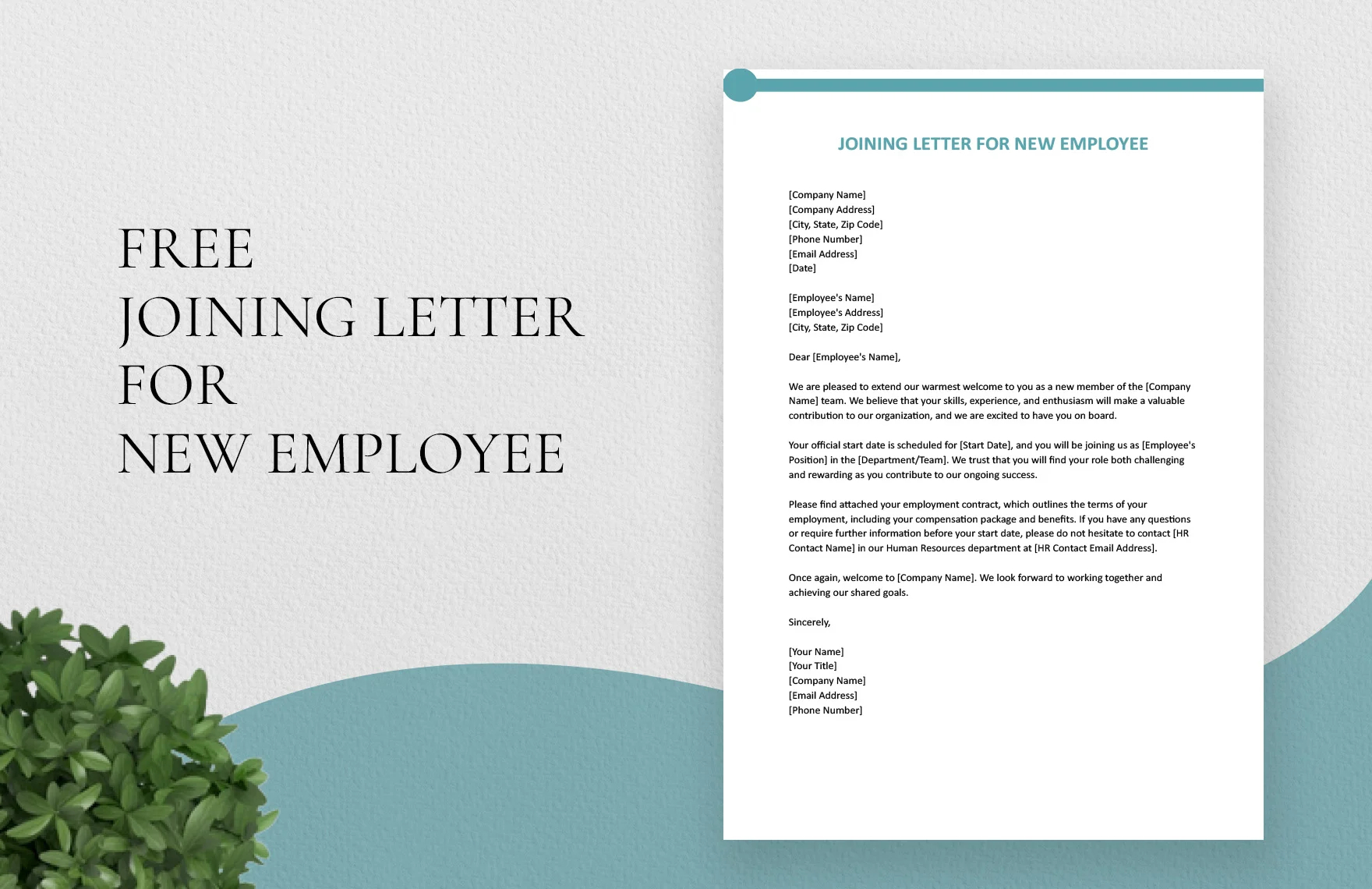
Difference between Offer Letter and Joining Letter
Understanding the distinction between an offer letter and a joining letter is crucial within the recruitment and hiring processes. These documents serve different purposes and are used at different stages of the employment cycle.
The Offer Letter: A Gateway to Employment
An offer letter is provided by the employer and marks the initiation of formal employment relations. It’s a formal document that outlines the details of the job offer, including the position offered, the salary, benefits, work schedule, starting date, and other terms and conditions of employment. The offer letter signifies the employer’s intention to hire the candidate and awaits the candidate’s acceptance.
Key Components of an Offer Letter
- Job Description: Detailed outline of the role and responsibilities.
- Compensation Details: Salary, bonuses, and other benefits.
- Start Date: The proposed date to begin employment.
- Employment Terms: Conditions such as probation period, employment status (full-time/part-time), and at-will statement.
- Company Policies: Brief mention of important policies the employee is expected to adhere to.
- Expiry Date: A deadline for the candidate to accept the offer.
The Joining Letter: A Commitment to Start
In response to the offer letter, a joining letter is sent by the candidate to the employer. This document confirms the candidate’s acceptance of the job offer and outlines their commitment to join the company on the agreed-upon date. It’s a courteous way to thank the employer for the opportunity and serves as an official notice of the candidate’s intent to begin employment.
Essential Elements of a Joining Letter
- Acknowledgment of the Offer: Reference to the offer letter and job title.
- Confirmation of Terms: Verifying agreement to the salary, start date, and other terms of employment.
- Expression of Gratitude: Thanking the employer for the opportunity.
- Enthusiasm for the Role: A brief statement expressing excitement to join the team.
- Professional Closing: Formal sign-off with the candidate’s signature.
The Sequential Order of the Documents
The offer letter comes first in the sequence. It’s the document that starts the official communication regarding employment. The joining letter follows as the candidate’s acceptance and confirmation to start employment based on the details provided in the offer letter.
Legal Standing and Implications
The offer letter can be considered a legal document that outlines the employer’s promise of employment under specified terms. It can be binding once accepted by the candidate. The joining letter, while more of a formality, also holds significance as it confirms the candidate’s understanding and acceptance of the offer and can serve as a written commitment from the candidate to the employer.
The Impact on the Hiring Process
Together, both documents facilitate a clear understanding between the employer and the candidate. They ensure that both parties are on the same page regarding the employment conditions before the start of the job, thereby minimizing misunderstandings and setting clear expectations.
In conclusion, the offer letter and the joining letter are both pivotal in the hiring process, serving to establish the terms of employment and confirming acceptance of those terms. They create the contractual foundation upon which the professional relationship is built and play a role in ensuring a smooth transition for the new employee into their role within the company.
Related Posts
Payment Letter Formats Samples & Templates
Business Proposal Letter to Client Samples & Templates
Company Introduction Letter Samples & Templates
Resignation Letter for Medical Samples & Templates
Letter of Intent Samples & Templates
Letter of Intent for a Job Samples & Templates
Lease Proposal Letter Samples & Templates
Letter of Inquiry Samples & Templates
Character Reference Letter Samples & Templates
Claims Letter Samples & Templates
Response Letter Sample & Templates
Follow Up Letter Samples & Templates
Sample Project Proposal Letter Templates
Donation Letter Samples & Templates
Addressing a Formal Letter Samples & Templates
